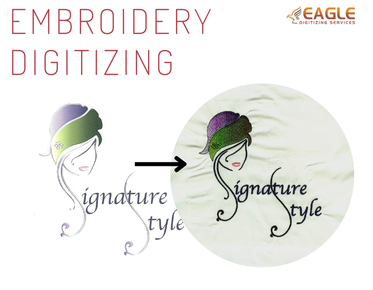Affordable Creativity: Outsourcing Embroidery Digitizing Tips
Welcome to the intricate and colorful world of outsourced embroidery digitizing. Whether you're an embroidery enthusiast or a business owner, the art of transforming designs into digital embroidery files is a fascinating process. Outsourcing this task can unlock a treasure trove of creative possibilities without breaking the bank.
Why Outsourcing Digitizing Can Boost Your Creativity
Outsourcing digitizing allows you to focus on your core creative tasks while leveraging the expertise of seasoned professionals. This approach not only saves time but also ensures your designs are rendered with precision and finesse. It’s a practical solution that enhances your productivity and expands your creative horizons.
Benefits of Outsourcing Embroidery Digitizing
Cost-effective Solutions for Your Business
Outsourcing digitizing can be a cost-effective solution, especially for small businesses. Instead of investing in expensive software and training, you can tap into the expertise of professional digitizers. This approach reduces overhead costs and allows you to allocate resources more efficiently.
Access to Professional Expertise
Professional digitizers bring a wealth of experience and technical knowledge. They understand the nuances of different fabrics, stitch types, and machine capabilities, ensuring your designs are optimized for the best results. Their expertise can elevate the quality of your embroidery projects significantly.
Finding the Right Digitizing Service
Key Qualities to Look for in a Digitizing Service
When selecting a embroidery digitizing service, look for qualities such as experience, portfolio diversity, and customer reviews. A reputable service should have a proven track record and the ability to handle a variety of design styles and complexities. Prompt communication and a commitment to quality are also essential.
Comparing Different Service Providers
Comparing different service providers involves assessing their pricing, turnaround times, and customer support. Request samples of their work to gauge the quality and attention to detail. Additionally, consider their ability to handle revisions and their responsiveness to inquiries.
Preparing to Outsource
Gathering Your Design Requirements
Before outsourcing, gather all necessary design requirements. This includes the artwork, preferred dimensions, color specifications, and any specific stitch types or techniques you want. Clear and detailed requirements help ensure the digitizer can accurately translate your vision.
Creating a Clear Brief for Your Digitizer
Create a comprehensive brief for your digitizer, outlining all design details and expectations. Include information on the fabric type, placement, and any special instructions. A clear brief minimizes misunderstandings and sets the stage for a successful collaboration.
The Outsourcing Process
Step-by-Step Guide to Outsourcing Digitizing
Outsourcing digitizing involves several steps. First, select a reputable digitizing service. Next, submit your design and brief. The digitizer will create the digital file and send it back for your approval. Review the file, provide feedback if necessary, and once satisfied, proceed to embroidery.
What to Expect from Your Service Provider
From your service provider, expect professionalism, timely delivery, and high-quality digitizing. They should provide regular updates and be open to revisions if needed. A good provider will also offer guidance on optimizing your design for the best embroidery results.
Communicating with Your Digitizer
Tips for Effective Communication
Effective communication with your digitizer is key to achieving the desired outcome. Be clear and concise in your instructions, ask questions if something is unclear, and provide timely feedback. Building a rapport with your digitizer can lead to better collaboration and results.
Providing Feedback and Revisions
When providing feedback, be specific about what changes are needed. Point out any discrepancies and suggest improvements. Most digitizing services offer a certain number of revisions, so take advantage of this to ensure the final product meets your expectations.
Understanding Digitizing Costs
Breaking Down the Cost Structure
Digitizing costs can vary based on factors such as design complexity, size, and turnaround time. Some services charge per stitch count, while others have flat rates for different design sizes. Understanding the cost structure helps you budget effectively and avoid unexpected expenses.
How to Budget for Outsourcing Digitizing
To budget for outsourcing digitizing, consider the frequency of your projects and the average cost per design. Allocate funds for potential revisions and rush orders. Comparing prices from multiple providers can also help you find the best value for your needs.
Evaluating Quality
How to Assess Digitizing Quality
Assessing digitizing quality involves examining the stitching accuracy, density, and overall execution. Look for clean lines, smooth curves, and consistent stitch patterns. Test the digital file on your embroidery machine to see how it translates to fabric.
Common Quality Issues and How to Address Them
Common quality issues include uneven stitching, puckering, and thread breaks. These can often be resolved by adjusting the digitizing settings or using different stabilizers and threads. Communicate any issues with your digitizer to identify and correct the underlying problems.
File Formats and Compatibility
Understanding Different Embroidery File Formats
Different embroidery machines require specific file formats. Common formats include DST, PES, and JEF. Ensure your digitizer provides the file format compatible with your machine. Understanding these formats can prevent compatibility issues and streamline the embroidery process.
Ensuring Compatibility with Your Embroidery Machine
To ensure compatibility, provide your digitizer with details about your embroidery machine, including the make and model. This information helps them generate the appropriate file format and optimize the design for your machine’s capabilities.
Turnaround Times
Managing Your Timeline for Outsourced Projects
Managing your timeline for outsourced projects involves planning ahead and setting realistic deadlines. Discuss turnaround times with your digitizer and factor in additional time for revisions. Effective time management ensures your projects are completed on schedule.
How to Handle Rush Orders
For rush orders, communicate the urgency to your digitizer and inquire about expedited services. Be prepared for higher fees for faster turnaround times. Clear communication and a willingness to compromise can help accommodate tight deadlines.
Troubleshooting Common Issues
Fixing Design and Stitching Problems
Design and stitching problems can arise even with professional digitizing. Common issues include thread breaks and misaligned stitching. Address these problems by consulting with your digitizer, adjusting machine settings, and using the right materials and stabilizers.
Working Through Miscommunications
Miscommunications can lead to unsatisfactory results. To work through them, maintain open and honest communication with your digitizer. Clarify any ambiguities in your brief and provide detailed feedback. Building a strong working relationship can help prevent future misunderstandings.
Creative Possibilities
Exploring New Design Opportunities with Outsourced Digitizing
Outsourcing digitizing opens up new design opportunities. Experiment with intricate patterns, detailed logos, and multi-colored designs that might be challenging to digitize in-house. Professional digitizers can bring complex ideas to life with precision and creativity.
Unique Projects Made Possible through Professional Digitizing
Professional digitizing can make unique projects possible, such as custom embroidery for events, personalized gifts, and branded merchandise. The expertise of a skilled digitizer allows for high-quality, bespoke designs that stand out and make a lasting impression.
Legal Considerations
Understanding Copyright and Licensing Issues
Understanding copyright and licensing issues is crucial when outsourcing digitizing. Ensure you have the right to use the artwork you’re digitizing. Discuss copyright and licensing terms with your digitizer to avoid legal complications and protect your intellectual property.
Ensuring Your Designs Are Legally Protected
To ensure your designs are legally protected, consider registering your work with the appropriate copyright office. Use contracts that specify the rights and responsibilities of both parties. Legal protection safeguards your creations and gives you peace of mind.
Maintaining Consistency
How to Ensure Consistent Quality Across Multiple Projects
Ensuring consistent quality across multiple projects involves working with a reliable digitizer and maintaining clear communication. Provide consistent feedback and establish standards for your designs. Consistency builds trust with your customers and enhances your brand reputation.
Tips for Building a Long-term Relationship with Your Digitizer
Building a long-term relationship with your digitizer involves fostering mutual respect and understanding. Regularly communicate your needs, provide constructive feedback, and show appreciation for their work. A strong partnership leads to better results and a smoother workflow.
Marketing Your Embroidery Business
Using Professional Digitizing to Enhance Your Brand
Professional digitizing can enhance your brand by producing high-quality, precise embroidery. Use these superior designs to create impressive samples and portfolio pieces. High-quality embroidery showcases your craftsmanship and attracts more customers.
Creating Eye-catching Samples and Portfolio Pieces
Creating eye-catching samples and portfolio pieces involves selecting your best work and presenting it professionally. Use these pieces in your marketing materials, social media, and customer presentations. A well-curated portfolio demonstrates your capabilities and appeals to potential clients.
Customer Satisfaction
Meeting and Exceeding Client Expectations
Meeting and exceeding client expectations requires delivering high-quality embroidery and excellent customer service. Communicate clearly with clients, understand their needs, and ensure timely delivery. Clients who are satisfied with your services are more inclined to return and suggest them.
Handling Customer Feedback and Revisions
Handling customer feedback and revisions involves listening to client concerns and making necessary adjustments. Approach feedback constructively and use it to improve your services. Offering revisions and showing a commitment to quality builds client trust and loyalty.
DIY vs. Outsourcing
When to Digitize In-house and When to Outsource
Deciding when to digitize in-house and when to outsource depends on your resources and project requirements. In-house digitizing is suitable for simple, quick projects, while outsourcing is ideal for complex, detailed designs. Evaluate the cost, time, and quality factors to make the best decision.
Balancing Cost, Quality, and Convenience
Balancing cost, quality, and convenience involves weighing the benefits of outsourcing against the investment in in-house digitizing capabilities. Consider your business needs and client expectations to determine the most efficient and cost-effective approach.
Outsourcing embroidery digitizing offers numerous benefits, including cost savings, access to professional expertise, and enhanced creative possibilities. By understanding the process, communicating effectively, and leveraging professional services, you can elevate your embroidery projects to new heights.
Embroidery is an ever-evolving art form with endless creative potential. Don’t hesitate to explore new techniques, experiment with different designs, and push the boundaries of your creativity. With the right resources and a trusted digitizing partner, the possibilities are limitless



